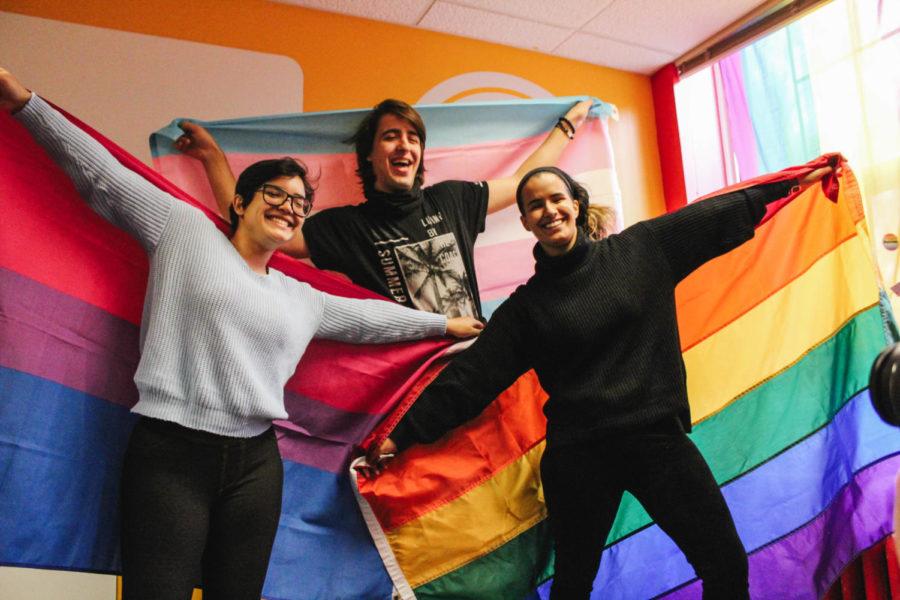Bisexual+ Awareness Week celebrates invisible community
Daniela Ortiz (left) holds a Bi pride flag, Alex Zafra (center) holds a Trans pride flag, and Iris Barreta (right) holds a Gay pride flag for the National Coming Out Day photoshoot at The Center on Oct. 11. The month of October is LGBTQIA+ History Month.
September 22, 2019
One week in September is a time of celebration for one often invisible community, the bisexual community. Bisexual+ Awareness Week goes from Sept. 16 to 23 and ends with Celebrate Bisexuality+ Day on Sept. 23.
Co-founded by Gay And Lesbian Alliance Against Defamation and BiNet USA in 2014, Bisexual+ Awareness Week is an annual digital campaign that seeks to accelerate acceptance of the bisexual+ community, which includes people who identify as pansexual, fluid, queer or those who don’t use a label.
According to the GLAAD website, Bisexual+ Awareness Week draws attention to the experiences, while also celebrating the resiliency of the bisexual+ community.
“During Bisexual+ Awareness Week you can do a lot,” said Brad Freihoefer, director of the Center for LGBTQIA+ Student Success. “For us this year we are really using online as our way to communicate and raise awareness around the bisexual+ community, to talk about the history, cultures, community and some of the policy issues around the bisexual+ community. It is a way to celebrate identities that can often be sometimes invisible on campus.”
Bisexuals make up close to 52 percent of the LGBTQIA+ community, according to the GLAAD website, yet they often are the most invisible due to their sexuality and the way it is expressed, this is called bi-erasure
“Bi people have been at the forefront of LGBT civil rights throughout history — actively helping to lead the Stonewall uprisings, organizing some of the first Pride events in the United States and lobbying for LGBT-affirming legislation — but are still too often left out of the conversation about equality, misunderstood or erased altogether,” said Sarah Ellis, president and CEO of GLAAD, in a press release.
Bisexual erasure or bisexual invisibility is a prevalent problem in which the existence or legitimacy of bisexuality is questioned or denied outright.
“Bi-erasure happens quite a lot,” Freihoefer said. “It is the idea that bisexual people don’t exist. People come to The Center and talk about how devaluing it feels and how inaccurate it is. Bi-erasure happens when folks suggest or don’t include the voices of bisexual folks and the goal of this week is to try and address that.”
For example, bi-erasure could be referring to two married women as a “lesbian couple” without considering that one or both women identify as bi. Some may insist that one of the married women can’t really be bisexual, her orientation doesn’t matter or her bisexual identity shouldn’t be mentioned now that she is partnered.
Considering a bisexual person as either gay or straight depending on the sex of the person’s partner, questioning the validity of bisexuality by calling it a “phase” or “confusion” or calling bisexuals “allies” to the LGBTQIA+ community are also forms of bi-erasure.
“Bisexual erasure plays a critical role in reducing the community’s visibility, and in turn reducing access to the resources and support opportunities bisexual people so desperately need,” according to the GLAAD website.
As a result of bi-erasure, those who identify within the bisexual+ community are often affected in many ways.
Fifty-eight percent of bisexuals are exposed to biphobic jokes at work, and 31 percent have been sexually harassed on the job because of who they are.
Just short of 60 percent of bisexual women live with anxiety and mood disorders, almost double the rate of their straight peers.
Sixty-one percent of bisexual women experience intimate partner violence, which is more than gay or straight men and women. Thirty-seven percent of bisexual men face the issue as well, which is more than gay and straight men or straight women.
Forty percent of bisexual high school students seriously considered attempting suicide with nearly one-third of the students actually attempting suicide.
“No one should have to hide their identity out of fear of discrimination, rejection or isolation,” Ellis said. All members of the LGBT community should be heard.”
Bisexual+ Awareness Week is considered to be the first bisexuality-specific advocacy campaign to trend nationally on social media because during the week, bisexual people around the world share their stories and speak to the community’s diverse experiences, which are then amplified in mainstream and LGBTQIA+ media outlets around the world.
In addition to leaving its mark in the digital world, Bisexual+ Awareness Week has provided an opportunity for on-the-ground advocacy. Several events are held around the country each year, from panels to gatherings with White House staff.
“[Bisexual+ Awareness Week], at its heart, is an educational campaign dedicated to celebrating the rich and diverse history of the bisexual community, in addition to furthering awareness and acceptance for bisexual people,” Ellis said.
















